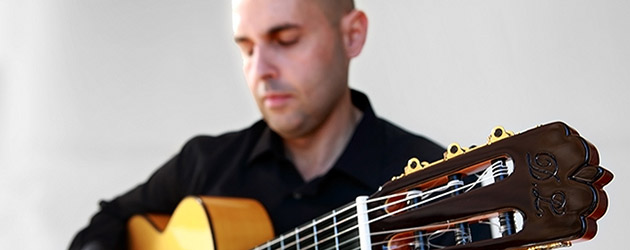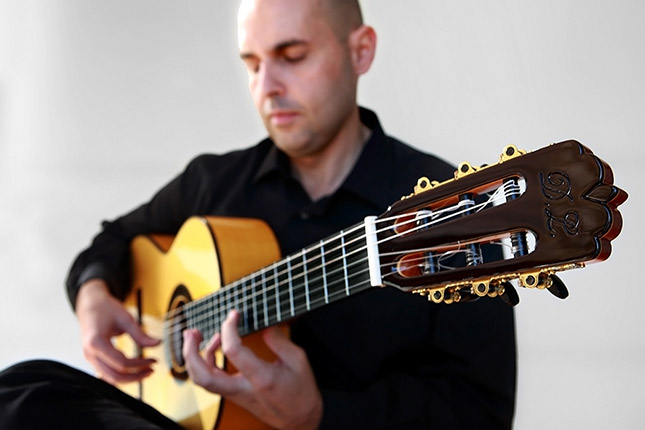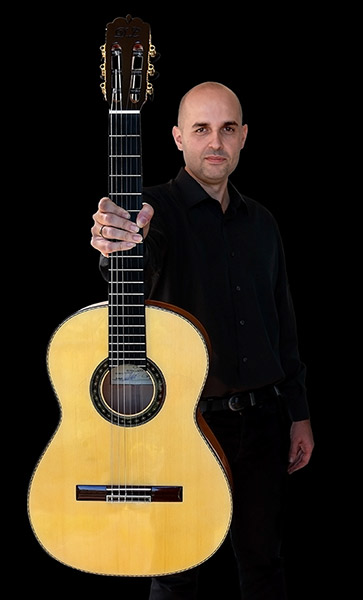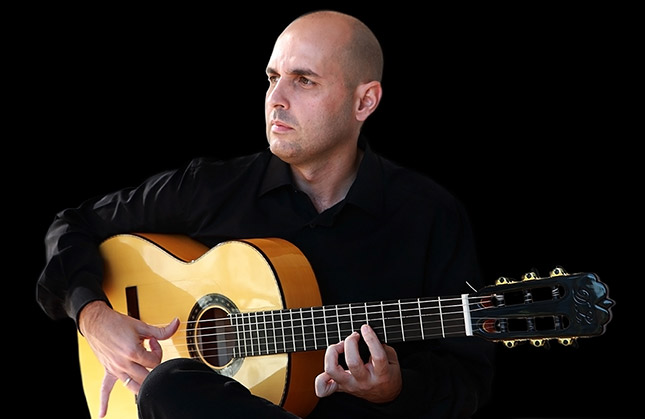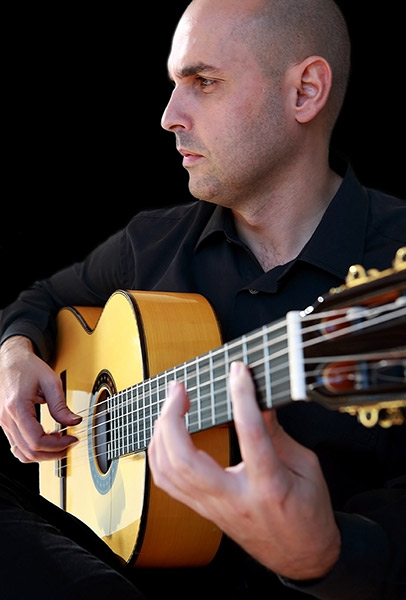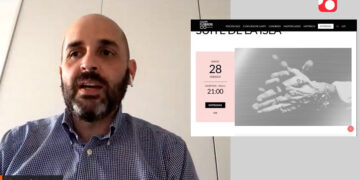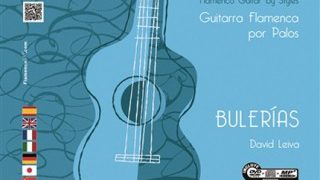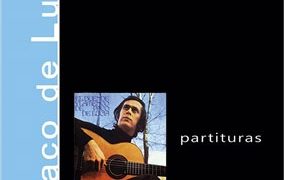Text: Silvia Cruz Lapeña
Photos: Raúl Torrent
We're speaking with David Leiva, researcher and flamenco guitar teacher, with more than 60 books published he is now facing the daunting task of transcribing the complete works of Paco de Lucía.
«Mozart was Mozart and he had no successors. The same will happen with Paco»
On the maestro's trail
David Leiva was born in Almería, but at the age of one, he moved to Cataluña with his family. You can see he's a quiet man who expresses himself without any haste, but moves with the motivation of those expecting something important to happen. In his case, a child, and since it's not his first, he put his concert schedule and jazz studies on hold, to concentrate on his research and flamenco guitar teaching. The most recent fruit of that task is “Antología de falsetas de Paco de Lucía», of which he has just brought out a volume devoted to bulerías, and which is only the first of 24 books that will eventually make up the collection. David knows well he is facing an enormous task: that of gathering, meticulously studying and transcribing all the falsetas the maestro recorded throughout his career, both solo and with singers.
We've agreed to meet with David at the Liceu Conservatory, where it's a pleasure to speak of music, and not at all strange to be talking about flamenco, thanks to the work of teachers such as Manuel Granados whom Leiva considers the person who taught him the most. «This is where I did my studies of flamenco, musical pedagogy and classical guitar» he explains. And here he has also been giving classes of cante accompaniment and other material for eleven years. David has 60 books published, he tunes and signs the instruments made by guitar-maker Juan Montes with whom he plans to produce a collection of concert guitars at affordable prices just in time for Christmas. «Many students comment that they can't buy a good guitar, and it occurred to us to make a series at a good price and with quality» he explains to Deflamenco.
The complex job of transcription
Speaking with him about his work on Paco de Lucía is very moving. A person who takes the time for minuscule analysis of each note and movement of the maestro, and who knows what he's doing, is someone you could talk to for hours. The work of transcription is similar to translation, especially because nothing is objective. Nor is sheet music. «I look for the falseta, I select it, I put the sound through a program, I isolate the falseta and listen to the sound a thousand times in order to play it on the guitar and put it to paper. And from there it's digitized». When you look at it like that, it sounds easy, but pinning down Paco de Lucía's music, although it's a delight, is no easy task. Especially considering the breakneck speed of some passages, and trying to get it properly transcribed.
This work, which is for teaching purposes, but also for the understanding and gathering of the material of the best guitarist of all time, occurred to him in 2013, and in it was hidden the desire to meet Paco de Lucía. «I didn't know him, and so I was happy he approved the project. We signed the contract the end of 2013, and in February he died, meaning my desire to ask him about many things also went up in smoke». Now he is continuing with the work, unable to ask questions, with the intention of going through the 24 volumes divided into eras and forms, the complete work of a maestro of whom he speaks wonders. «If I had to choose, I'd take the clean sound. But it's that he also had speed, he was strong and complete as far as composition». Leiva, who meticulously follows the chronological order of de Lucía's work, claims it was always evolving, that even in the early era, when he was very influenced by Niño Ricardo and some things of Sabicas, you could see his composing ability.
The book is conceived for anyone who plays the guitar, beginner or expert, and Leiva, being a teacher, can't help giving some advice: «I recommend listening to the record that contains the book, using the metronome and playing along with Paco de Lucía». Now there's some laughter, because he says it just like that, as if there were nothing to it, but he knows it's not easy. «It's plenty hard to follow Paco de Lucía. But there are programs that allow you to lower the speed of the audio. I use one to transcribe and recommend students use it to practice».
A maestro without heirs
We start talking about new technology, because David is also a teacher by correspondence thanks to Skype. «I have students in China, Taiwan, Italy and the United States. Unfortunately, none in Spain, and even though you can't move the students' fingers, I have to admit it feels a lot like a face-to-face class». Leiva claims new technology has only helped the teaching and practicing of guitar. «Recording programs, audio, websites and pages where you can learn to play guitar, or Skype itself, allow this knowledge to reach many places and makes certain jobs much easier». Leiva makes use of the new technologies to give his classes, and that's why he created a teaching method through which his students can accompany Fosforito, Camarón and Antonio Mairena. He does point out however, that no technology can take the place of the many hours of practice an instrument requires, and fortunately the guitar allows few shortcuts. He, who has also accompanied singers like Juan Pinilla and Nano de Jerez, claims that with a singer it's easier to gloss over a mistake, but concert guitar allows for little fakery.
That comment opens the door to speak about today's guitarists, where Leiva foresees little evolution. «The thing is, Paco de Lucía invented everything 50 years ago. What can we possibly do now? Lots of good guitarists come out, they play nice things, but I think the guitar is stuck in a rut», explains Leiva who excludes from this group Diego del Morao, Vicente Amigo, Gerardo Núñez and not many more. When asked how much «blame» to pin on Paco de Lucía for this, Leiva has plenty to say. «He was the maestro, we all looked up to him, it's only normal that we copy him. But that obsession with copying him has led, inevitably, to a uniformity of sound».
He glosses over these observations, preferring to get back to the maestro. Following as he does the trail of each and every note ever played by Paco de Lucía, he again emphasizes the musicality of the man from Algeciras. «En Siroco for example, you can see what an interpreter he is. There are strong flourishes, gentle passages, shading…things you see in classical music!» explains Leiva enthusiastically, ending with the solemn declaration that no, Paco de Lucía has no heirs. «Mozart was Mozart and had no successors. It's the same with Paco».
Descubre más desde Revista DeFlamenco.com
Suscríbete y recibe las últimas entradas en tu correo electrónico.


